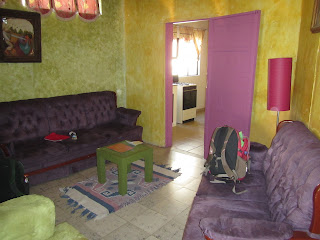
Our hostal was located somewhere behind the cathedral. Where? We sure couldn't tell from the online directions. So we stopped the Tourist Police and the two women actually walked us to it. We would never have found it through the various twists and turns and yes, in behind the cathedral, through a connecting walkway.
 Danny trying one of the local venders of honey mead along the route
Danny trying one of the local venders of honey mead along the routeHere we toured the one and only major tourist site - the Sanctuary of Our Lady of Guadalupe.

 This is not only a cathedral but a museum. Unfortunately, after we had paid our entrance fee, we discovered that various parts of the multi-focal museum were closed. We did however, get to see the fabulous murals depicting St Francis of Assisi's life
This is not only a cathedral but a museum. Unfortunately, after we had paid our entrance fee, we discovered that various parts of the multi-focal museum were closed. We did however, get to see the fabulous murals depicting St Francis of Assisi's life 
as well as the cathedral itself.
 is this not reminiscent of the various missions in the US?
is this not reminiscent of the various missions in the US? wouldn't this make a wonderful quilting motif?
wouldn't this make a wonderful quilting motif?Touring the city, we saw a multitude of different, yet similar architecture as well as statues:
 flying buttresses but with a twist - some of these have been filled in to make extra rooms in a now defunct church.
flying buttresses but with a twist - some of these have been filled in to make extra rooms in a now defunct church. the city water tap was actually at the base of this statue. Now, what did that guide say about the significance of the stance of the horse? I can't remember!
the city water tap was actually at the base of this statue. Now, what did that guide say about the significance of the stance of the horse? I can't remember! and what would a "Silver City" be without a silver mine? Zacatecas, like Guanajuato, has a mine right within the confines of the city and we thought that we could walk to it as the map indicated only a few streets away. Yes, well, that was true if only we had realized that only the major streets were on the map and that the area that we were going to was all uphill.
and what would a "Silver City" be without a silver mine? Zacatecas, like Guanajuato, has a mine right within the confines of the city and we thought that we could walk to it as the map indicated only a few streets away. Yes, well, that was true if only we had realized that only the major streets were on the map and that the area that we were going to was all uphill.  And when we found ourselves where we wanted to go, we had to turn around and go down many flights to get to the mine.
And when we found ourselves where we wanted to go, we had to turn around and go down many flights to get to the mine. tour transportation
tour transportation old miner greeting the visitors - rub his belly for good luck they say (sounds a lot like what you do with Buddha)
old miner greeting the visitors - rub his belly for good luck they say (sounds a lot like what you do with Buddha)But the most amazing thing was what else was there, down in the mine - a discotheque with a glass (?plexiglass) floor over an open mining shaft/pit and a "conjugal room" rented by the hour with a bed carved out of the rock.
Food - have I talked about food yet? Oh yes, I mentioned the walking tacos but ... here in Zacatecas we probably had the best gourmet meal that we have had since Europe. The restaurant was a small one, tucked away on a side street, with food to die for. Lucky Luciano's is a feast for the eyes as well as for the taste buds. Juan, the chef, was trained in Belgium and he brought that continental flair back with him. He originally worked out of the Cancun restaurant, going all over the world but has now come home to stay in Zacatecas. As for the eyes, there is more than the wonder of the food - Juan has been collecting art from around the world and has hung it all in his restaurant. Every conceivable inch is covered.











































